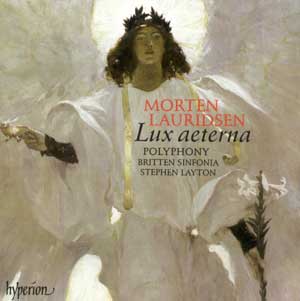Music Reviews - Classical and Jazz - No. 52 - May, 2005
 |
|||||||||
| CANTELOUBE: SONGS OF THE AUVERGNE �
VERONIQUE GENS, ORCHESTRE NATIONAL DE LILLE, JEAN-CLAUDE CASADESUS NAXOS 8.557491 (also available as an SACD)
|
|||||||||
The history of music is filled with one-off composers who would have faded
into obscurity had they not written a few works so memorable and engaging
that we return to them again and again. Such is the case with Marie-Joseph
Canteloube de Malaret (mercifully known as Joseph Canteloube), a pupil of
Vincent d�Indy.
Most of Canteloube�s classical compositions remain virtually unknown.
Rather, it is his Songs of the Auvergne (Chants d�Auvergne), five sets of
folk-song arrangements for voice and orchestra composed between 1927 and
1955 that have earned him widespread recognition. Canteloube bathed songs
collected from France�s Auvergne region (just south of the country�s
geographic center) with broad washes of orchestral color, using brilliant
instrumental highlights to illuminate their enchanting lyric beauty and
na�vet�.
Just as every soprano with the pipes to do them justice longs to tackle
Richard Strauss� Four Last Songs, so have countless lyric sopranos and high
mezzos recorded the Songs of the Auvergne. The songs �Ba�l�ro� and
�Brezairola� (Lullaby) are especially popular, their long-breathed, wistful
lines providing balm for the soul. Even singers who do not possess the verve
required to convince in jaunty melodies such as �Malurous qu�o uno Fenno�
(Unfortunate is He Who Has a Wife) – Kiri Te Kanawa comes to mind -- have
set down treasurable interpretations of �Ba�l�ro� and other soothing gems.
The latest entry in a recorded lineage that began in the 1930�s with
Madeleine Grey�s earthy interpretations of songs from Canteloube�s first
four sets (Pearl) comes from soprano V�ronique Gens and the Orchestre
National de Lille conducted by Jean-Claude Casadesus (Naxos). Not only has
Gens provided consistently distinguished singing in Ren� Jacobs�
award-winning Mozart recordings, but Naxos has flattered her artistry by
issuing an audiophile quality hybrid SACD disc.
Orchestrally, the recording is a major achievement. Casadesus makes the most
of Canteloube�s billowing colors and shimmering effects, intelligently
pinpointing solo instruments to underscore words and melodic intervals. As
much as I favor Karina Gauvin�s recent, beautifully recorded interpretation
with chamber orchestra (CBC Records), the use of the larger orchestral
forces Canteloube intended brings greater pleasure. Canteloube junkies
enamored of Netania Davrath�s incomparably charming versions of the songs
(Vanguard Classics), sung in authentic dialect with an unpretentious,
somewhat thin little girl voice that sounds far more like a peasant�s than a
diva�s, don�t realize how much more there is to Canteloube�s music when his
orchestral writing receives its proper due.
Unfortunately, Gens� timbre is ill suited to these works. She can be quite
touching in �La dela�ss�do,� a song about a shepherdess deserted by her
lover (although Arleen Auger and Frederica Von Stade can tear your heart
out), but mostly she sounds like either a patrician Countess summarily
displaced to the lowlands or a slightly dowdy soprano who is pushing too
hard. There�s much beauty to her singing, but the voice type works best in
other contexts.
At Michael Tilson Thomas� recent 60th birthday gala celebration, the great
Frederica von Stade amazed her audience by singing two of Canteloube�s gems
with a voice and spirit that belied her age. After Flicka�s �Uno Jionto
Postouro� (A pretty shepherdess) wept for the lover who had deserted her
with heartbreaking hollowness, her �Lou Coucut� chirped away with enough
energy to power every clock on the planet. I don�t have von Stade�s early
Auvergne recordings on CD, but memory declares them superb. Arleen Auger
(Virgin Classics) and Victoria de los Angeles (EMI) offer comparable
contrast and spirit – Auger, recorded two years before her death, tears me
apart in �La dela�ss�do� -- while the far more even, low-keyed Karina Gauvin
offers singing so beautiful and heartfelt as to make Canteloube�s music a
portal to heaven�s gates.
![]()
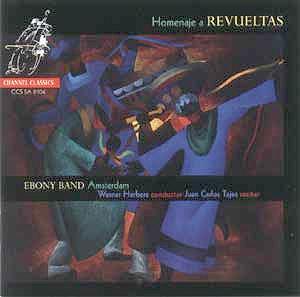 |
|||||||||
EBONY BAND AMSTERDAM: HOMENAJE A
REVUELTAS � CHANNEL CLASSICS SACD CCS-SA- 21104
|
|||||||||
In the astounding music of Mexican composer Silvestre Revueltas
(1899-1940), the joy and exuberance of Mexican life and its virtually
phantasmagoric shadow side of superstition, Catholic repression, and
suffering go hand in hand.
Revueltas was a true original. A violin player from age eight, he matured to
tour the southern United States and Mexico as a violin soloist and conductor
in the 1920s. Coming to the attention of composer Carlos Chavez, he was
summoned to work with the Orquestra Sinf�nica de M�xico to help create music
with a distinct national identity. In the ten years following, he produced a
large body of colorful compositions with a distinctly Mexican and
revolutionary flavor.
In 1936, Revueltas became secretary-general of the League for Revolutionary
Artists and Writers and visited Spain to show his support for the
anti-fascist movement. Seeing his hopes for freedom seemingly defeated by
the darkening political landscape, he returned to Mexico disillusioned. He
continued to compose and drink excessively until he died of pneumonia at age
41.
Performed by the Ebony Band of Amsterdam on this superbly recorded hybrid
SACD (offering the option of multi-channel playback with sound so good that,
even on regular CD players, MP3s sound like trash in comparison), the disc
begins with one of Revueltas� most famous compositions, Sensemay�. Usually
heard in its spectacular orchestral version, this short, savagely rhythmic
piece about the ritualistic killing of a poisonous snake is offered in its
original form for 15 instruments.
Most striking is the final work on the disc, the three-movement Hommaje a
Frederico Garc�a Lorca, a tribute to the great Spanish homosexual poet who
was slain in 1936 by fascist soldiers. The first movement, Baile, starts
mournfully, but quickly transitions into a bizarre carnival burlesque of
Mexican peasant music. (Russia�s Alfred Schnittke wrote works in a similar
vein much later in the century). After the mournful Duelo por Garc�a Lorca,
the concluding movement, Son, presents a distinctly exuberant Mexican
celebration around a gravesite. This is a great, beautifully recorded music
that honors a voice that must be heard.
![]()
TWO GREAT SINGING ACTRESSES
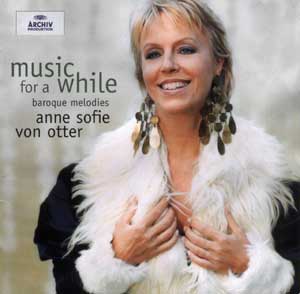 |
|||||||||
ANNE SOFIE VON OTTER: MUSIC FOR A
WHILE: BAROQUE MELODIES � DG B0003460-02
|
|||||||||
Having heard mezzo-soprano Anne Sofie von Otter live three times in the
past year, most recently on April 27 in Mozart�s final opera seria, La
Clemenza di Tito at the Met, my admiration for her versatility and artistry
have continued to grow. Some have disparaged her gorgeous CD collaboration
with Elvis Costello, suggesting that pop singing (including her forthcoming
recording of ABBA and her coy San Francisco Christmas recital encore of
�Santa Baby�) provides an easy way out for a vocalist past her prime. But
save for a tight high B-flat in her Met performance of Mozart�s �Parto,
parto,� I have heard nothing to suggest that the just-turned 50-year old
singer is in decline.
Von Otter�s latest solo recording finds her in splendid vocal and histrionic
estate. Variously accompanied by Jory Vinikour�s authentic harpsichord &
chamber organ, Jakob Lindberg�s theorbo, lute & Baroque guitar, and Anders
Ericson�s theorbo, the program reminds us that, as much as she has won
prestigious awards for CDs of song programs dedicated to Brahms, Grieg,
Schumann, Chaminade, French and Swedish composers, and Costello, von Otter�s
legacy of baroque recordings that began with Monteverdi and Bach in 1987 has
won her two awards for her Handel.
Some singers approach Baroque music with politeness. Not von Otter. Guided
by scholarly research into period practice, she launches into Benedetto
Ferrari�s jovial �Amanti, io vi so dire� (Lovers, I can tell you that it is
much better to flee from a pretty woman�) with jocular passion, whooping it
up like a female in hot pursuit. That she manages to maintain a coherent
musical line while underscoring Ferrari�s multiple shenanigans is much to
her credit.
Von Otter quiets down as appropriate for many of the ten songs by Purcell
and Dowland that comprise the bulk of the program. With her accompanists
eschewing conventional string bass continuo to provide what the liner notes
call �greater intimacy� (i.e., increased prominence for the voice),
Purcell�s �Sweeter than Roses� and Dowland�s pristinely accompanied �In
darkness let me dwell� are lovely. But when she turns Barbara Strozzi�s
�Udite, amanti� (Hear, lovers, the cause oh god, that brings me to tears)
into over-the-top melodrama, Anne Sofie von Otter�s imprimatur as a singing
actress comes to the fore. With the inclusion of some wonderful instrumental
solos – Vinikour�s harpsichord in Bernardo Storace�s Ciaccona is especially
fine – this is a great disc for baroque-lovers.
|
|
|||||||||
MARIA CALLAS: LIVING AND DYING FOR
ART AND LOVE � TDK DVUS-DOCMC
|
|||||||||
This compelling 60-minute BBC production, directed by Steve Cole,
intersperses excerpts from rare footage of Maria Callas and Tito Gobbi�s
famed 1964 Covent Garden Act II of Puccini�s Tosca (plus vocals and stills
from other performances of the period) with commentary from such renowned
singers as Grace Bumbry, Placido Domingo, and Gobbi himself. Additional
insights from conductor Antonio Pappano and most importantly, director
Franco Zeffirelli, make the DVD indispensable.
As many times as I�ve seen footage of Callas and Gobbi in Covent Garden�s
fully staged Tosca Second Act, I have never appreciated it more than in this
context. To witness Zeffirelli hoarsely describe how he coached Callas, and
then immediately see her amplifying his direction, illuminates her genius
better than 20 other Callas biographies and documentaries combined. Not only
do we learn from Zeffirelli and Gobbi what was staged and what was
spontaneous, but Bumbry, Domingo, and Pappano (plus other artistic
luminaries that include Dame Judi Dench) offer an additional level of
appreciation that further deepens our ability to assess Callas� achievement.
Only 18 months before the 41-year old soprano abandoned the operatic stage
entirely due to vocal decline, she rallied for her Covent Garden Tosca
performances. Yes, she emitted a wobble or two, but they are negligible in
the context of singing and acting so profound as to render pedestrian much
of what passes as drama on today�s stages.
Callas could still produce a vulnerable, sweet tone when called for, all the
more miraculous when contrasted with the well of personal suffering that lay
at the core of her Tosca voice. Moving with extraordinary freedom, with
gestures worthy of a ballerina�s and facial expressions second to none,
Callas illuminates Floria Tosca�s tragedy like no other. Thanks to
biographical commentary that sets the stage for her incomparable
performance, this DVD is a must.
![]()
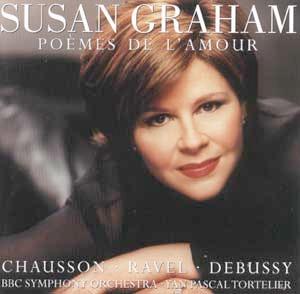 |
|||||||||
SUSAN GRAHAM: PO�MES DE L�AMOUR �
WARNER CLASSICS 2564 61938 2
|
|||||||||
The sensual expressiveness and beauty of Susan Graham�s plush
mezzo-soprano has earned her well-deserved international reknown. Po�mes de
l�Amour, her latest Warner release, provides ample evidence that the 44-year
old artist is now at the height of her powers. Ably supported by the BBC
Symphony Orchestra under Yan Pascal Tortelier, Graham delivers incomparable
renditions of music by Chausson, Ravel, and Debussy.
Graham has always been at her finest in French repertoire. The reasons lie
in the innate warmth and beauty of her instrument, whose sound seems to
radiate from her heart, and her temperamental affinity with the
introspective sensuality of French impressionism.
Graham�s artistry finds an ideal vehicle in the sensual passion of Ernest
Chausson�s extended three movement Po�me de l�amour et de la mer. Her
presentation of the work�s opening words,
"The air is filled with the exquisite scent of lilacs
whose blossoms cover walls from top to bottom
and perfume women�s hair,
masterfully conveys the mystical atmosphere of Chausson�s universe."
Greatly influenced by the music of Richard Wagner, Chausson dives from the
heights of romantic expectation into the abyss of despair. As his expectant
lover experiences the death of love, Graham rides Chausson�s waves of
emotion as if she were riding the crests of the sea. It�s a gorgeous
performance, made all the more special by her ability to illuminate text,
not with the obvious verbal underscoring of a Schwarzkopf or Bostridge, but
rather with powerful inner conviction and unrivaled tone. Graham�s liquid
soft high notes recall the sweet power of Janet Baker�s in her prime.
If the protagonist of Chausson�s Po�me rides the waves of emotion, the
narrator in Ravel�s Sheh�razade surfs way over the top. Graham�s performance
of the 28-year old Ravel�s setting of three exotic poems by the eponymous
Tristan Klingsor is so passionate as to leave even R�gine Crespin and Ernest
Ansermet�s classic version of Ravel�s early masterpiece sounding deficient
by comparison.
Every stereotype of Asian culture known to the West, including pot-bellied
mandarins holding parasols, princesses with slender hands, and executioners
who chop heads with curved oriental swords seems to surface in Sheh�razade�s
dramatic extended opening movement. The two shorter sections that end the
work are more horizontal in nature, their sensuality ideal for Graham�s
artistry. With Crespin�s recording I admired the unfailing beauty of tone
and watched the counter on the CD player; with Graham I became enthralled.
The final works on the disc, Claude Debussy�s early Cinq Po�mes de Charles
Baudelaire, reveal a young composer in search of himself. Berkeley�s John
Adams helps Debussy along by orchestrating four of the songs, but the
influence of Wagner nonetheless inhibits Debussy from finding his unique
voice.
Five years after writing Cinq Po�mes, Debussy d�buted his far more
distinguished La Damoiselle �lue on the same Paris concert that saw the
d�but of Chausson�s Po�me de l�amour et de la mer. If the recital thus comes
full circle, it has the ever-gratifying Graham and Tortelier�s sympathetic
support, rather than engineering that blurs orchestral detail and grants the
mezzo�s close-miked voice an occasional edge, to thank for its success.
![]()
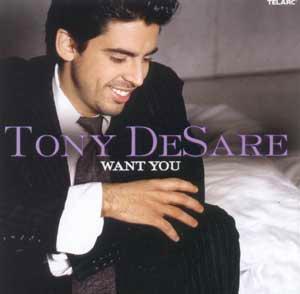 |
|||||||||
TONY DESARE: WANT YOU � TELARC HEADS
UP CD-83620
|
|||||||||
Frank Sinatra is alive and well, returning to the stage in fresh form.
Tony DeSare, A new presence on the scene, hails from Glen Falls, New York.
He has been singing and playing piano professionally since age 17. With his
direct, unmannered style, intimate lower range, clear enunciation, and
downright sexy delivery, DeSare comes naturally to those jazz-tinged love
ballads that have made woman and beast swoon for the last 70 years.
The title song �Want You� by DeSare and Mark Lee showcases the singer at his
fresh, irresistible best. Another team effort, �I�d Have It All (If I Had
Drew)� is the title song from My Date With Drew, a multiple award-winning
independent documentary slated to hit theaters nationwide. Another winner,
�We�ve Got a World that Swings,� originally debuted in Jerry Lewis� film,
The Nutty Professor. These three selections alone guarantee DeSare an
audience eager for more.
This d�but effort receives impeccable support from the great jazz guitarist
Bucky Pizzarelli, pianist Ted Firth, guitarist Joe Palermo, and a group of
seasoned professionals that includes Mike Lee, John Swana, Bob Howell, Vic
Stephens, and Brian Czach. Pizzarelli has been performing with DeSare since
2002, and has continually championed the young artist.
Every song on this album feels good. The disc opens with a fabulous
rendition of Cy Coleman and Dorothy Fields� �Baby, Dream Your Dream� from
the musical Sweet Charity; it joins such standards as �Two for the Road,�
�Just in Time,� and �I Wish You Love.�
The final track, DeSare�s enjoyable if not overtly brilliant piano solo on
Grandma�s beloved �Five Foot Two,� unites nostalgia and modern romance in an
irresistibly handsome package. Tony DeSare will surely bring audiences to
their feet as he tours with Harold Arlen�s son in the tribute show Arlen on
Arlen and receives nationwide publicity for this seductive disc. His vocal
range may not be as wide as Sinatra�s, but his spirit, voice, and way with
words are if anything fresher and more universal than an artistry sometimes
pitched to the late night cocktail, smoky bar, Vegas crowd.
![]()
|
|
|||||||||
MORTEN LAURIDSEN: LUX AETERNA �
HYPERION CDA67499 (also available as an SACD)
|
|||||||||
Morten Lauridsen, born in 1943 in Colfax, Washington, shares with English
composer John Rutter the ability to write some of the most uplifting and
frequently programmed choral music of the present era. Although not all of
Lauridsen�s work is sacred in nature, it is his Christian-inspired music,
which rivals Arvo P�rt�s in its ability to capture the transcendent peace
and love that are the essence of Christ�s teaching, that most readily
touches the heart.
The performances at hand, for which Lauridsen was present, feature the
exceptional British choir Polyphony under the direction of Stephen Layton
with instrumental support from the Britten Sinfonia. Polyphony is not
another of those white-voiced, chaste sounding British choirs whose sacred
music performances have a telltale white gloved feel. Rather, thanks to
their founding conductor, the choir�s beautifully detailed, expressive
singing breathes life and health into Lauridsen�s works. The sopranos are
especially radiant, the other voices perfectly matched and balanced. Having
been entrusted with premieres of works by such modern masters as Sir John
Tavener, Arvo P�rt and Thomas Ad�s, Layton�s Gramophone Award winning
singers are ideally suited for Lauridsen�s music.
Sandwiched between the five movements of Lauridsen�s serene, 27-minute Lux
Aeterna (1997) and three equally gratifying, shorter sacred works from the
same period (Ave Maria, Ubi caritas et amor, and the oft-heard O magnum
mysterium), the CD features Six �Fire Songs� on Italian Renaisssance Poems
(1987). These Madrigali, inspired by the music of Monteverdi and Gesualdo,
are quite erotic in nature. Unified by the recurrent symbolic imagery of
flames, their sometimes dark and despairing texts provide pointed if not
particularly searing counterpoint to the light-filled serenity of
Lauridsen�s exalted spiritual music.
![]()
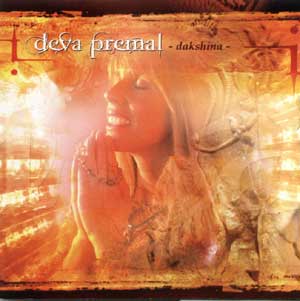 |
|||||||||
DEVA PREMAL: DAKSHIMA � NARADA
724386029126
|
|||||||||
So writes Deva Premal, best known for her vocals on the top-selling chant CDs The Essence, Love is Space, and Embrace. Years after their release, these albums still rate highly on New Age charts and are heard in yoga studios and centers worldwide.
Although I confess resistance to blond haired Caucasians singing westernized versions of traditional Indian chants and mantras, Deva Premal is something else. Since 1991, she and her partner Miten, followers of the late Osho (formerly known as Yogi Bhajan), have sung the praises of various Indian Gurus (conveyers of the light), Gods and Goddesses with a sincerity and passion that can melt all but a cynic�s heart.
Miten, originally from England, began as a singer-songwriter-guitarist, opening for Fleetwood Mac and Ry Cooder in the �70s. Discovering the power of meditation, he left the world of rock behind. He eventually met up with Deva Premal in an ashram. After she spontaneously began singing harmony with him as he sat on the edge of his bed playing guitar, a relationship ensued.
Together, the duo has traveled the world, performing for audiences that have included the Dalai Lama, author Eckhart Tolle, motivational speaker Tony Robbins, and the incomparable Cher. They�ve also sold over 400,000 CDs.
I doubt the duo�s early recordings were as processed as this, with major label
Narada�s multi-tracked reverb, pop feel, and sundry concessions to marketable
gratification. Yet Deval Premal and Miten�s purity of purpose remains strong,
perhaps no more beautifully expressed than in �Aad Guray,� Snatam Kaur
Khalsa�s modern version of a mantra from the sacred writings of the Sikhs.
Another winning track, �Brahma Nandam,� part of the teaching of Lord Shiva to
his consort Paravati, describes the guru-disciple relationship as the
essential means of attaining Enlightenment.
Yes, there are a few tracks where musical inspiration seems somewhat mundane.
Regardless, the devotion with which this duo chants shines through. There is
bliss, truth and beauty here.
- Jason Victor Serinus


